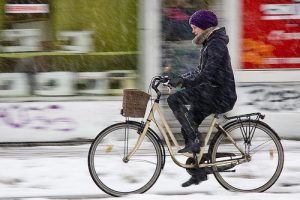“There’s no such thing as bad weather, only unsuitable clothing.”
– Alfred Wainwright
The vagaries of the British weather can throw up surprises for cycle commuters at any time of the year, but it is the cold, dark winter days that will provide the greatest test of riders’ resolve. With winter feeling like it finally arrived in earnest this month, it’s worth investing in a bit of preparation and the right gear. That done, anyone can enjoy the benefits of travelling by bike all year round.
The Bicycle
There’s no denying that your bike has it a lot tougher in the winter months, so you need to show it a little more love and attention. It’s a good idea to get a thorough service in order to make sure that everything’s in good nick, particularly the brakes (which must be set up well to be effective in the wet) and the drive train.

Once everything’s running smoothly regular maintenance is vital to keep things that way and to get rid of the grit and grime that is thrown up from wet roads. You won’t always feel like spending an extra five minutes cleaning your bike once you get home, but making the effort once in a while will be worth it in the long run.
Nothing makes the cyclist’s heart sink like the dreaded P-word, so to avoid having to utter it, invest in some tyres with decent puncture protection. It’s also a good idea to check your tyres every so often for bits of grit, stone or glass that have lodged in the rubber. Often these don’t cause a puncture immediately you ride over them, but can work their way down over time, so a quick once over can actually prevent flats. Wider tyres will give better traction in slippery conditions, as will running them at a lower pressure. A recommended pressure range for tyres is given on the sidewall.
When riding on wet roads the biggest enemy to your comfort is the water sprayed up from the wheels that, if unchecked, will soak your back and legs in no time. Mudguards will stop the worst of this, particularly if they are the close fitting type (see this guide), and the cyclist behind you on the road will have reason to thank you too.
Clothing
If you don’t already own them you’ll want to go shopping for a waterproof jacket and a pair of gloves. Even on the coldest days you should avoid wearing too heavy a jacket. You might be surprised by how much warmth you generate cycling and a thick overcoat will soon have you overheating. The jacket doesn’t necessarily have to be a cycle specific product, although these will tend to be cut differently (long in the arms and long at the back) to suit a stretched out riding position.
Hands are particularly susceptible to wind-chill and so as soon as the mercury starts to drop it’s on with the gloves. Specialist cycling gloves will have extra padding on the palm, dampening vibrations from the handlebars. Another useful feature built in to some gloves is a section of towelling material that can be used to wipe away sweat and rain.
Apparently it’s not true that most body heat is lost through the head, but having a chilly bonce is undeniably not much fun, so a warm hat is a must. For helmet wearers an underhelmet hat can be a good option.
Visibility
Good lights, front and rear, are essential for winter riding. Bright clothing also improves visibility, although if fluorescent jackets don’t meet your style criteria a less garish garment with some reflective elements built in might offer an acceptable compromise.
The other important way to make sure you are seen is to ride confidently. Riding too close to the kerb, dipping in between parked cars, and filtering on the left of queuing traffic will all reduce your visibility to other road users.
Technique
Riding in the wet and the dark presents its own challenges but shouldn’t be too daunting for the confident rider. Many techniques which are good practice in all weathers become even more so during winter.
As noted above, for reasons of visibility it’s never a good idea to ride too close to the kerb. What’s more, in poor conditions, rainwater, grit and other debris collect in the part of the road adjacent to the kerb and can cause punctures and accidents. Potholes should be avoided, as, when filled with water, it can be impossible to gauge their depth. Take extra care also when riding over painted lines and metalwork in the road, as these can become much more slippery when wet.

If you find yourself riding on ice, as can sometimes happen, try not to panic. Stop pedalling, ride in a straight line, and avoid braking if possible as grabbing a lever will tend to be the quickest way for you to meet the ground.
What’s my motivation?
Years of experience cycling every day in London confirms that complete soakings are less frequent than you might think. You can expect somewhere around 6-8 of them in a whole winter’s worth of Monday to Friday commuting.
And when the going really does get tough, try to focus on the benefits you will have already accrued through you choice of transport. The money saved, the fitness gained, the calories burnt.
So you see, there really is no such thing as bad weather.
Leave a Reply